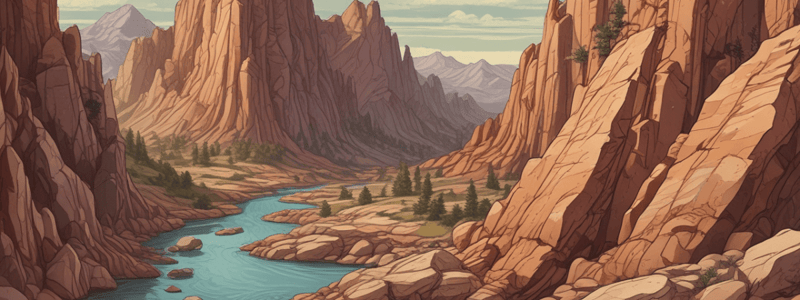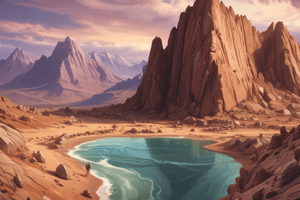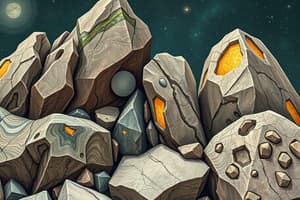Podcast
Questions and Answers
What is the term for naturally occurring aggregates of geological material?
What is the term for naturally occurring aggregates of geological material?
- Minerals
- Lava
- Rocks (correct)
- Magma
What is the primary difference between intrusive and extrusive igneous rocks?
What is the primary difference between intrusive and extrusive igneous rocks?
- Their chemical composition
- Their location of formation (correct)
- Their color
- Their texture
What is the term for molten rock that rises above the Earth's crust?
What is the term for molten rock that rises above the Earth's crust?
- Intrusive rock
- Magma
- Lava (correct)
- Extrusive rock
What is the process that leads to the formation of igneous rocks?
What is the process that leads to the formation of igneous rocks?
What is characteristic of intrusive igneous rocks?
What is characteristic of intrusive igneous rocks?
What is the primary use of diorite in construction?
What is the primary use of diorite in construction?
What is the process that leads to the formation of sedimentary rocks?
What is the process that leads to the formation of sedimentary rocks?
What is an example of an organic sedimentary rock?
What is an example of an organic sedimentary rock?
What type of rock is formed through the change in rock type due to environmental factors?
What type of rock is formed through the change in rock type due to environmental factors?
What is unique about the grain structure of basalt?
What is unique about the grain structure of basalt?
What type of metamorphic rock is formed when magma rises to the upper crust of the Earth?
What type of metamorphic rock is formed when magma rises to the upper crust of the Earth?
What is the process by which rocks are cycled over time?
What is the process by which rocks are cycled over time?
What type of metamorphic rock is slate?
What type of metamorphic rock is slate?
What is the type of metamorphism that occurs along fault lines where continental plates rub against each other?
What is the type of metamorphism that occurs along fault lines where continental plates rub against each other?
What type of sedimentary rock is marble formed from?
What type of sedimentary rock is marble formed from?
Flashcards are hidden until you start studying
Study Notes
Rocks
- Rocks are naturally occurring aggregates of geological material, called minerals.
- There are three major types of rocks: igneous, sedimentary, and metamorphic rocks.
Igneous Rocks
- Formed from the cooling and solidification of molten rock (magma).
- Magma cools and solidifies beneath the Earth's crust or on the surface as lava.
- Igneous rocks can be classified into two types:
- Intrusive igneous rocks: solidify within the Earth's crust, characterized by large, visible crystal formations.
- Extrusive igneous rocks: formed by the cooling and solidification of lava on the Earth's surface, characterized by small, invisible crystal structures.
- Examples of igneous rocks include:
- Granite (intrusive): a common rock with large crystal structures, used in construction and decorative materials.
- Diorite (intrusive): a coarse-grained rock used in construction and road building.
- Basalt (extrusive): a common rock rich in iron and magnesium, used in construction and statue making.
Sedimentary Rocks
- Formed from the lithification of sediments, which are particles formed by the weathering of rocks or dead organic matter.
- Sediments can be transported, deposited, and accumulated, eventually becoming lithified (turned into rock).
- Sedimentary rocks can be classified into three types:
- Clastic sedimentary rocks: formed from the lithification of clasts, which are produced by the weathering of other rocks.
- Organic sedimentary rocks: formed from the lithification of sediments from organic materials, such as bones, shells, and teeth.
- Chemical sedimentary rocks: formed when water evaporates and produces sediments of dissolved matter.
- Examples of sedimentary rocks include:
- Siltstone (clastic): a classical example of a clastic sedimentary rock.
- Sandstone (clastic): formed from the lithification of silt particles, used in construction and decorative materials.
- Limestone (organic): formed from the depositing, accumulation, and lithification of calcium-rich organic matter.
- Sea salt (chemical): formed when large amounts of sea water evaporate and leave behind the dissolved salts.
Metamorphic Rocks
- Formed through the metamorphosis of sedimentary or igneous rocks due to environmental factors like heat, pressure, or chemical environments.
- Metamorphic rocks can be classified into two types:
- Foliated metamorphic rocks: characterized by the presence of parallel bands of minerals running through the rock.
- Unfoliated metamorphic rocks: formed when pressure is milder across the rock during metamorphosis, without distinct bands of minerals.
- Examples of metamorphic rocks include:
- Marble (unfoliated): a metamorphic rock used in making monuments and sculptures.
- Slate (foliated): a fine-grained rock formed from mudstone or shale, used in roof tiles and flooring.
- Phyllite (foliated): a metamorphic rock formed when shale is subjected to low levels of heat and pressure, used in decorative rock formations.
The Rock Cycle
- Describes how geological material, such as rocks and minerals, are cycled over time.
- Considers the relation between igneous, sedimentary, and metamorphic rocks and how transformations occur between each type.
- The rock cycle involves the continuous transformation of rocks into different types over time, recycling the same geological material.
Studying That Suits You
Use AI to generate personalized quizzes and flashcards to suit your learning preferences.




